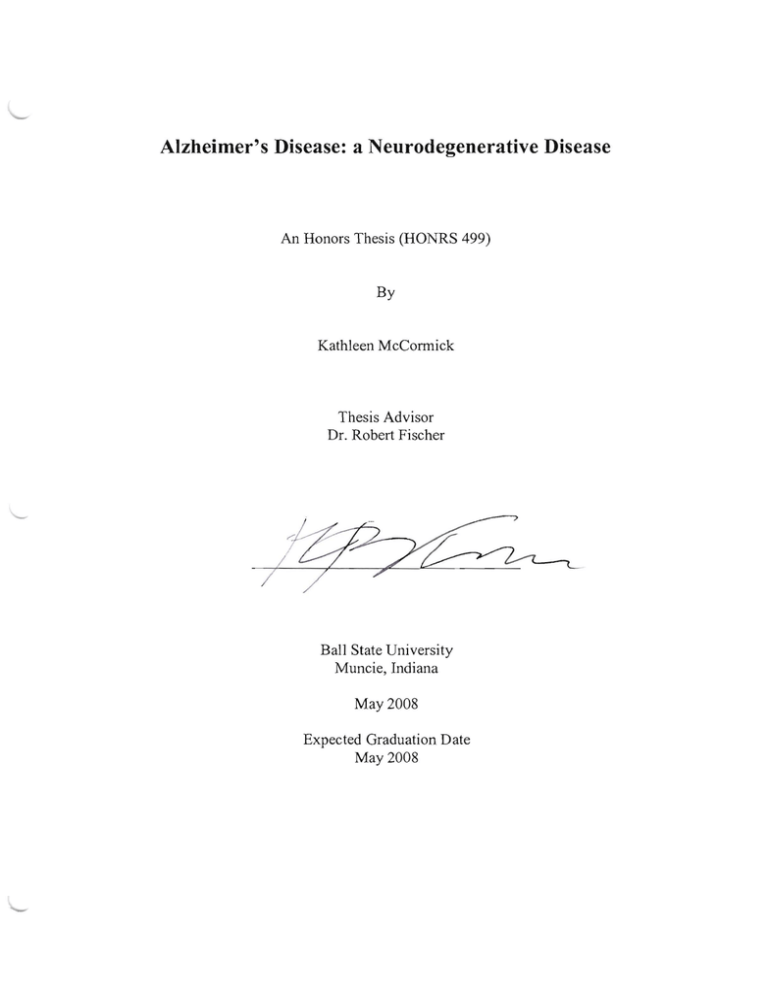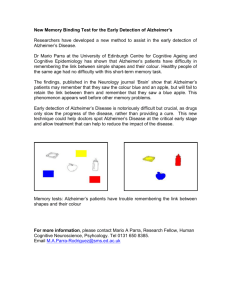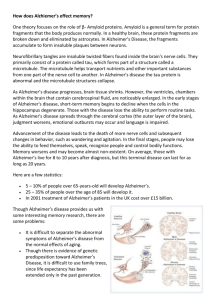7 ~ Alzheimer's Disease: a Neurodegenerative Disease
advertisement

Alzheimer's Disease: a Neurodegenerative Disease An Honors Thesis (HONRS 499) By Kathleen McCormick Thesis Advisor Dr. Robert Fischer 7~ Ball State University Muncie, Indiana May 2008 Expected Graduation Date May 2008 S;p Co) ) T heS i S 1-£ ~ Abstract 1-)59 . 2. 1-/ 6J,oog ./V)37"" Alzheimer's disease, an incurable neurodegenerative disease, plagues millions of Americans. The scientific community has put Alzheimer's disease at the forefront of research and hundreds of organizations and labs are dedicated to providing a broader understanding of the disease. This thesis will review the current research on disease etiology, diagnostic tools, risk factors and treatment. Acknowledgements I would like to thank Dr. Fischer for advising me through this thesis project and sparking my interest in physiological psychology. I would also like to thank Christy and Bryan McCormick for proofreading this paper and providing support. In 1907, Dr. Alois Alzheimer was presented with a patient who lacked physical abnonnalities but had significant problems with memory, thought, learning, and behavior. Peculiarly, the symptoms arose at the age of 51 with no hint of problems earlier in life. The patient's mental capacities progressively deteriorated, and after 5 years the illness took her life. Upon autopsy, Dr. Alzheimer noted significant cerebral atrophy with visible lesions. Tissue sampling revealed aggregated neurofibrils in regions where neurons had once been. His characterization and detailed, careful notes on the case lead to the discovery of a new neurodegenerative disease, named after the physician- Alzheimer's disease (AD) (Lage, 2006). Alzheimer's disease now plagues an estimated 5.2 million Americans, with 1 in 8 people above age 65 developing the disease. The majority of cases are seen in adults above age 65, however roughly 200,000 individuals will develop the disease before age 65. It is projected that by the year 20307.7 million Americans will be diagnosed with AD (Alzheimer's Association, 2008). The disease not only robs individuals of their memories, ability to think, and independence, but also greatly impacts the lives of the their family and friends. Often the care giving responsibilities are filled by family members, who must witness the slow deterioration of a loved one's mind and altogether livelihood. Unfortunately, the disease is incurable and current treatments only have the ability to postpone disease onset. Since the early 1990s there has been a boom in Alzheimer's disease research. With the contributions of molecular and genetic research the fonnerly unknown mechanism of Alzheimer's is being pieced together. The Human Genome project was monumental in understanding the locus and function of genes associated with the disease, such as the presenilins (PSI and II), amyloid-B precursor protein (APP), and apolipoprotein E (ApoE). Molecular 2 research of the amyloid-B (AP) plaques, neurofibrillary tangles, and neuronal death has provided a platform for future research and a more complete understanding of the neurodegenerative disease. Sporadic vs. Familial Alzheimer's AD can be classified into two categories: dominant familial Alzheimer's disease and nondominant (sporadic) Alzheimer's disease. Of the two, sporadic AD is the most common accounting for approximately 90-95% of AD cases (Goedert, 2006). Dominant familial AD involves an inherited mutated form of AP cleaving and regulating genes (APP, PSI, or PSII). Sporadic AD is a result of reduced AP clearance, inheritance of the E4 allele on the apolipoprotein E (ApoE) gene, or impaired degradation of Ap. Both forms have a common result in the accumulation of an altered form of AP and follow the same disease progression (Selkoe, 2002). Age is the greatest risk factor for developing AD with increasing probability starting after age 65. Average age of onset in sporadic AD is 85, however individuals possessing the ApoE E4 show onset earlier. Dominant familial AD reduces age of onset up to 30 years earlier (LeVine, 2004). Disease Progression Alzheimer's hallmark characteristics, AP deposits and tau-containing neurofibrillary tangles, target and induce neuronal death within a select group of cells in the cerebral cortex, specifically the pyramidal neurons (F elician & Sandson, 1999). The neurons susceptible to developing the abnormal protein aggregations are neurons with long, thin axonal projections in relation to cell body size, while the short-axoned cells typically escape the lesions (Braak, 2006). Another distinguishing characteristic is the degree of myelination- the proj ection neurons are 3 unmyelinated or have a single coat, while the short-axon neurons are typically heavily myelinated. The suspected underlying mechanism involves the energy requirements of an unmyelinated neuron compared to a myelinated neuron. Unmyelinated neurons have higher energy demands for impulse conduction and thus have higher oxidative stress imposed on the cell compared to myelinated neurons (Braak, 2006). Current research suggests the progression of neuronal impairment and death reversely follows the myelination progression. Initially, A~ plaques are found within the amygdala and temporal and parietal high-order association regions. As the disease progresses, plaques can be found in the meningeal and cortical blood vessels with plaque extension into temporal limbic structures (Felician & Sandson, 1999). Tau protein abnormalities, or neurofibrillary tangles, are also seen with the progression of the disease but current histological diagnosis focuses only on A~ plaque distribution (Felician & Sandson, 1999). AD progresses in 6 stages (1- VI), Stage I is limited to the cortical cells of the superficial transentorhinal region and as the lesions in the transentorhinal region become more severe the disease progresses into Stage II . Stage II also sees progression of lesions extending to the hippocampus. As lesions worsen AD progresses into Stage III where the disease extends to the neocortex of the ocipitotemporal region. During Stage IV, the already present lesions become more pronounced and the high order association centers of the neocortex become involved along with the superior temporal gyrus. Stage V and VI see further progression of lesions into frontal and occipital neocortex (Braak, 2006). Amyloid Cascade Hypothesis The mechanism of AD pathology is currently unknown, however the main consensus of the scientific community is that the A~ protein is the key player in the disease progression. In 4 the early 1990s, John Hardy, along with other contributors, proposed the "Amyloid Cascade Hypothesis." This hypothesis proposes that mutations in the A~ cleaving genes cause the deposition of A~ plaques, which then results in neuronal injury and subsequent death (Hardy & Selkoe, 2002; Hardy, 2006; Felician & Sandson, 1999). The hypothesis has received criticism in recent years, however the nature of a hypothesis allows it to be flexible, and as research builds more evidence and support, the hypothesis changes. Another argument in AD research concerns the tau protein and its role in the amyloid cascade hypothesis. Recent evidence shows that the neurofibrillary tangles (containing tau) are not able to induce the A~ plaque formation seen in AD, even at neurotoxic concentrations. Furthermore, neurofibrillary tangles are seen after the deposition of A~, which is supported by animal model studies (Hardy & Selkoe, 2002; LeVine, 2004). In familial AD, the genes controlling and influencing A~ cleavage are mutated and can accelerate the age of disease onset giving more support to the amyloid hypothesis. In addition, clinical trials of A~ immunization treatment showed cognitive stabilization and in some cases improvement (LeVine, 2004). Similar to other neurodegenerative diseases like Parkinson's or Huntington's disease, the problem is often accumulation and reduced clearance of a misfolded protein, much like the A~ protein seen in Alzheimer's (LeVine, 2004). All of which provide further support for the amyloid cascade hypothesis. Abnormal Filaments A~ plaques, neurofibrillary tangles, neuronal death and lesions are hallmark characteristics of AD. They are present at various concentrations in every AD brain. The abnormal filaments, A~ and neurofibrillary tangles, are the suspected culprits of neuronal death and synaptic loss, however their toxic mechanisms are still under debate. 5 AI3 is a product of proteolytic cleavage of the large amyloid precursor protein (APP). APP is a transmembrane protein and has various isoforms with lengths ranging from 590-680 amino acids (Carter & Lippa, 2001). The 695- amino acid form is predominantly found in neuronal cells, while other isoforms can be found in neuronal and non-neuronal cells (Felician & Sandson, 1999). Its function is unknown, but it is suspected to playa role in neurite extension, interneuronal signaling, cell-cell communication and neuroprotection (Carter & Lippa, 2001; Macconi et.al, 2001). Recent research suggests APP is a vesicle receptor for kinesin, meaning it is involved in intracellular trafficking. Deregulation of intracellular trafficking may playa role in the AD pathology (Mac coni et.al, 2001). APP is cleaved to produce AI3 peptides composed of 39-43 amino acids. Three proteases are responsible for APP cleavage, which are a, 13, and y- secretase. a-secretase cleaves within the AI3 domain, leaving the carboxy and amino terminals of AI3 within APP (Carter & Lippa, 2001; Macconi et.al, 2001). 13- secretase, an alternative cleavage pathway, cleaves at the amino terminal generating a peptide containing AI3. The final cleavage pathway includes y- secretase, which cleaves AI3 at the carboxy terminal. The generation of the full length AI3 is a result of 13- cleavage followed by y-cleavage (Carter & Lippa, 2001; Goedert, 2006; Felician & Sandson, 1999). y-cleavage results in the variation between 40-42 amino acids of the AI3 peptide (Carter & Lippa, 2001). These variants differ by number of amino acids at the C-terminus. This area determines the solubility of the peptide (Felician & Sandson, 1999). The AI3 variant, containing 40 amino acids, is soluble and is found in higher concentrations within neuritic plaques of mature dense AI3 plaques of AD patients (Felician & Sandson, 1999; Carter & Lippa, 2001). The A1342 compared to the A1340 variant is the more neurotoxic of the two and has a higher likelihood of forming 6 plaques. A~40 appears to be the main component of the insoluble fibrils and the soluble oligomers associated with A~ plaques (LeVine, 2004). In cognitively normal patients, A~40 is seen in higher concentrations than A~42 (Carter & Lippa, 2001). Most A~ is produced within the cell and remains in the intracellular compartment with a small amount destined for extracellular secretion (LeVine, 2004). The A~42 is produced in the endoplasmic reticulum and mostly remains intracellularly, while the A~40 is produced in the Golgi apparatus for exocytotic secretion (LeVine, 2004). While it is thought that the A~ seen in extracellular plaques is produced within the cell, the hypothesis currently lacks sufficient support (Carter & Lippa, 2001). The A~ secreted from the neuron is in the form of monomers and dimers and when it reaches the interstitial fluid it polymerizes into soluble A~ oligomers, which can be cleared (Kumar-Singh, 2008). In AD, the oligomers aggregate into high molecular weight proto fibrils to create diffuse plaques and eventually create the dense plaques characteristic of AD (Kumar-Singh, 2008). A~ is normally present in the cerebrospinal fluid (CSF); the brain synthesizes the protein which is then deposited into the CSF to circulate through the central nervous system (LeVine, 2004). Neuronal cells and non-neuronal cells produce A~ in normal homeostatic states and its production is mediated by the influx and efflux of the peptide (Levine, 2004). The normal rate indicates that A~ is rapidly produced and cleared from the CNS; however, the A~ accumulation in the AD brain is 100-200 times that seen in control brains (Bateman et.al, 2006). In familial AD, there is an over-production of total A~ or A~42' but in sporadic AD (99% of the cases) it is unknown whether the A~ plaque accumulation is a result of overproduction of A~ or decreased clearance (Bateman et.al, 2006). A~ is degraded by macrophages, proteases, and the cerebral 7 blood vessels. The metallopeptidases responsible for breaking down A~ include neprilysn, insulin-degrading enzyme, endothelial-converting enzyme-1 and -2, and metalloproteinase-2 and -9 (Kumar-Singh, 2008). A~ is also cleared via low-density lipoprotein receptor-related protiein- 1 (LRP-1) across the blood brain barrier, where the LRP-1 receptors are influenced by ApoE (Kumar-Singh, 2008). The tau molecule plays another important role in the suspected mechanism of AD pathology. The neurofirbillary tangles seen within neurons were found to be composed of paired helical filaments of the tau protein. Tau is a family of proteins that is associated with microtubule stabilization of the intraceullular cytoskeleton ofaxons and neurite formation (Chun & Johnson, 2007). While is can be expressed in other cells (glial cells and oligodendrocytes), it is predominantly expressed in neurons. Recent evidence shows that tau may also be involved in vesicle transport and axonal polarity (Chun & Johnson, 2007). Normally tau is highly soluble and remains in an unfolded conformation with little secondary structure. In AD, tau becomes compacted into fibrils, which is facilitated by truncation at the carboxy terminal and selective amino acid phosphorylation (Chun & Johnson, 2007). The hyperphosphorylation of tau promotes the self-assembly of the protein into paired helical filaments, a hallmark characteristic seen in AD brains (Chun & Johnson, 2007; Macconi et.al. 2001). Normal phosphorylation of tau is the mechanism thought to produce the stabilizing effect on axon cytoskeletal structures. The inability of tau to interact with microtubules is suspected to induce the toxic internal state leading to neurodegeneration (Goedert, 2006). The neurofibrillary tangles characterisitic of AD are found primarily in the neurons of the hippocampus, entorhinal cortex, and amygdala (Macconi et.al. 2001). The neuroprotective effects of tau are dependent on protein kinases, such as cyclin-dependent kinase 5 (Cdk5) and 8 glycogen synthase kinase-beta (GSK3P), which prevent the hyperphosyphorlyation oftau and the subsequent neuronal death associated with AP toxicity (Macconi et. aI, 2001). One study suggests that hyperphosphorylation is a reversible process, but the self-aggregation of tau into tangles is permanent. Once the tangles appear the cell can no longer enter the cell-cycle and undergo neurogenesis (Schindowski et.al, 2008). AP deposits in the interstitial fluid are thought to promote the degradation of the neurofibrillary machinery, however the process is not completely understood at this time. Mechanism of Neuronal Death At the time, there is no universally accepted mechanism of neuronal death in AD. The amyloid hypothesis, discussed earlier, suggests that AP has a toxic effect on neuronal dendrites and synapses. The support for this hypothesis comes from studies showing AP to be neurotoxic, however, there is little support for the presence of Ap alone causing direct neuronal death (LeVine, 2004). One other suspected mechanism, is the production of AP40 and AP42 within the neuron produces toxic effects intracellulary by interfering with neurona1 function, specifically synaptic plasticity (Venkitaramani et.al, 2007). Intreneuronal AP interferes with glutamate receptors, which are critical in synaptic plasticity and memory explaining the cognitive impairment seen in AD patients. This mechanism is supported by studies of familial AD where the genes responsible for cleaving APP (presenilins) are mutated. These genes are not only responsible for cleaving APP but also other proteins causing the accumulation of AP and other possibly neurotoxic proteins (LeVine, 2004). The early-onset of AD in the familial type suggests that AP and these other proteins are involved in the death process. 9 Another hypothesis involves the deregulation of Calcium (Ca2+) and the increased concentrations intracellularly. Nomlally, Ca2+ regulation is under strict control, but research has shown the addition of AP to in vitro cells disrupts Ca2+ signaling and produces an influx of Ca2+. This influx of Ca2+ may playa role in activating cellular enzymes, apoptosis, and cause modification to the cytoskeleton (Bojarski et.al, 2008). Presence of AP may also lead to lipid oxidation of the semi-permeable bilayer of the cell causing conformational changes of ion channels allowing the influx of Ca2+. The influx ofCa2+ then increases the generation of AP, exacerbating the original problem in a positive feedback loop. It is known that AP induces cellular apoptosis in vitro and enhances cellular death through oxidative stress. The typical apoptoic pathway, including membrane blebbing, chromatin fragmentation, and capsase activation can be seen in neuronal cultures (Eksyyan & AW,2004). The oxidative stress as a result of AP exposure is still under investigation. Oxidative stress is a direct result of oxidants overpowering antioxidant molecule abilities. In AD there is an overproduction of reactive oxygen and nitrogen species, such as nitric oxide, superoxide, hydrogen perioxide and perioxynitrite (Maccioni et.al, 2001; Hayashi, 2006). The presence of these oxidants causes cellular damage and can signal apoptosis. The AP peptides and oligomers, along with oxidative stress, triggers an inflammatory response by the brain's immune system. Studies show increased cytokine concentrations in AD patients compared to age-matched control patients (Felician & Sandson, 1999). The cytokines and neuroimmune modulators of the brain are thought to playa role in both neuroprotection and neurodegeneration (Rojo et.al, 2008). Interleukin-1 (IL-1) is suspected to enhance neurodegeneration by upregulating tau hyperphosphorylation and by inducing the production of nitric oxide, an oxidant, within neurons (Rojo et.al, 2008). Interleukin-6 (IL-6) another cytokine 10 released by activated glial cells also plays a role in neuroinflammation and cognitive impairment. Interestingly, IL-3 plays a role in neuroprotection, showing that the cytokines are complex and have various involvements in AD. Along with cytokines, neuroinhibitory molecules (semaphorin 3A, collapsin-response mediator protein 2, etc.) are suspected to playa role downstream of initial AP deposition to result in neuronal damage (Lamer & Keynes, 2006). The large-scale neuronal damage and death are responsible for the cognitive impairments seen in AD. The degeneration process begins in the entorhinal cortex and extends to the hippocampus, dentate gyrus, and is followed by neuronal loss of the neocortex and the nucleus basalis of Meynert (Masliah et aI, 2008). Neuronal death in these crucial areas leads to the memory loss, attention deficits, mood changes, logic impairments and confusion experienced in an AD patient. The underlying mechanism is loss of functioning synapses resulting from the toxic AP plaques, tau-containing neurofibrillary tangles, oxidative stress, and cytokines of neuroimmune cells (Mashliah et.al, 2008). Genetics of Alzheimer's Disease AD is a genetic disease with known linkages to mutated genes. Mutations in the APP processing gene, presenilin-l and -2, as well as the ApoE gene are linked to familial (earlyonset) AD. Currently all of the genes associated with AD result in improper processing of APP causing the accumulation of AP peptides (Tan don et.al, 2000). The APP gene is located on chromosome 21, which also the gene associated with Down's Syndrome. People with Down's Syndrome eventually present Alzheimer's-like symptoms, which is correlated to the additional copy of APP in their genome. Mutations on the long arm of chromosome 14 have been linked to a mutated form of presnilin-I (PSI), and mutations on chromosome I have been linked to presenilin-2 (PS2) 11 dysfunction (Felician & Sandson, 1999). These two genes account for 50-70% of familial dominant AD cases and result in early-onset of the disease (Felician & Sandson, 1999). The physiological role of these proteins is unknown, but it is thought they are involved in intracellular trafficking and AP production (Felician & Sandson, 1999). Evidence shows that the presnilins influence the y-secretase cleavage pathway and promotes the production of AP (Tandon et.al, 2000). Knock-out mice, lacking the presnilin complex, show decreased AP production due to only u- and p-secretase activity. The gene encoding ApoE lies on chromosome 19, and mutations of this gene are associated with increased susceptibility of developing sporadic AD or late-onset familial AD. The gene has 4 alleles, with the 84 allele being the most lethal, such that two copies of the allele are associated with earlier disease onset (Hirono et.al, 2003). Inheritance of the ApoE 84 allele can result in a 20-year shift in disease onset (Tandon et.al, 2000). ApoE 84 alters the processing of APP, binds with AP, and competes with AP peptide for clearance through the LRP-l (Tandon et.al, 2000). Diagnosis AD diagnosis typically begins with the primary care physician recognizing slight dementia and calling for further cognitive functioning tests. Unfortunately, AD is recognized when the symptoms begin to interfere with the individual's everyday life, which are signals of moderate to severe AD (Grober et.al, 2008). Current diagnostic tools include global cognitive function screening tests and brain imaging. In order to c1inical1y diagnosis dementia there must be cognitive impairment in memory, so the primary diagnostic tools measure memory and similar functions (Grober et.al, 2008). 12 Zaven Khachaturian, an AD researcher, describes four categories of assessment tools used in diagnosing dementia including mental status exams, global measures of dementia severity, behavioral scales, and cognitive assessment batteries (Khachaturian, 2006). Mental status exams include Mini-mental Status Exam and Short Blessed Test, while the global measures of dementia severity use tests such as the Global Deterioration Scale and CAMDEX. Behavioral scales include the Geriatric Depression Scale to rule out dementia as a result of depression; and the cognitive assessment batteries include the Alzheimer Disease Assessment Scale (Khachaturian, 2006). The Mini-mental State Examination (MMSE), a mental status exam, is the most commonly used tool in assessing cognitive functioning in AD patients (Apostolova et.al, 2006). The MMSE tests for cognitive decline through testing patients on memory, language, short-term memory, orientation, thought construction and attention (Apostolova et.al, 2006; Grober et.al, 2008). Interestingly, Apostolova and fellow researchers have been able to correlate MMSE score decline with cortical atrophy in the temporal, parietal, and frontal association cortexes, with respect to gray matter density (Apostolova et.al, 2006). Early AD is difficult to diagnosis due to the nature of disease in that memory and cognitive impairments arise later in disease progression- it is estimated the neurodegeneration begins 20-30 years before the appearance of the clinical symptoms (Goedert, 2006). One aim of current research is to develop diagnostic tools that will recognize AD at its earlier stages. Brain imaging research is working in that direction so that AD can be diagnosed and treated earlier in the disease progression. The National Institute of Aging established the Alzheimer's Disease Neuroimaging Initiative (ADNI) promotes the discovery of new diagnostic tools and to improve 13 the current imaging methods (ThaI et.al, 2006). There are numerous types of brain imaging techniques, and some are more useful than others. Positron emission topography (PET) displays glucose uptake through imaging regions of the brain that are actively taking up radio-labeled 2-deoxyglucose. Most PET scans of AD patients show a decreased glucose uptake in the parieto-temporal association cortex and the cingulate gyrus compared to control patients (Wu & Small, 2006). However, the PET scan does not show the entorhinal cortex, the region holding the hippocampus. Another method of imaging is through visualizing cerebral blood flow by using PET, single photon emission computed tomography (SPECT), and magnetic resonance imaging (MRI) (Wu & Small, 2006). The cerebral blood flow imaging methods typically show decreased perfusion in the temporal and parietal cortex areas and also reduced blood flow to the entorhinal cortex (Wu & Small 2006). The MRl imaging technique shows the best spatial resolution in that it is able to visualize the entorhinal cortex, the region suspected to undergo neuronal death in early AD. Conclusion As more individuals enter late adulthood their risk of developing AD significantly increases. By 2030 an estimated 7.7 million Americans will be diagnosed with this disease. It is necessary that we develop more effective diagnosing tools so that AD can be found in its earliest stages. A better understanding of the underlying mechanism in disease progression should be at the forefront of AD research. With a better understanding of the molecular and structural abnormalities seen in AD we can work towards developing better treatment and disease prevention. 14 Currently, AD treatment is palliative with no cure. The drugs prescribed to AD patients temporarily delay the onset of more severe symptoms. Cholinesterase inhibitors are frequently prescribed; they slow the breakdown of acetylcholine, a neurotransmitter necessary for memory formation (Nordberg, 2006). Memantine, a relatively new drug used to treat moderate to severe AD, serves as an NMDA receptor antagonist by blocking excess glutamate in the synapse from disturbing signal transmission (Reisburg et.al, 2003). Antioxidants may also be administered to reduce the oxidative stress on hippocampal neurons, however there is limited evidence showing antioxidants to have a significant effect on delaying AD symptoms (Morris et.al, 2006). Neurotrophic factors, such as nerve growth factor, brain-derived neurotropic factor, and fibroblast growth factor-2 have been identified as a future direction of AD treatment. Specifically, nerve growth factor has been shown to prevent the death of basal forebrain cholinergic neurons in promising animal studies (Tuszynski, 2007). While AD cannot be prevented, a few delaying factors have been identified. Aside from age and genetic risk factors, education, leisure activities and occupation are seen as the top three delaying factors. Low educational levels are directly related to a higher risk of developing AD. It is believed education increases cognitive reserve by increasing synaptic connections (Gatz et.al, 2006). Cognitively stimulating leisure activities have been shown to lower the risk of AD and possibly protect against dementia. Activities such as traveling, reading, playing musical instruments, board games, and dancing were included in what is thought to be cognitively stimulating. Finally, occupations with high mental demand and low physical demand are at a lower risk for developing AD (Gatz et.al, 2006). The future of AD largely depends on the scientific research and funding of organizations and labs dedicated to unfolding the basis of this disease and to the development of better 15 diagnostic methods and more effective treatments. In the last 20 years, AD has come to the forefront of aging and neurodegenerative research and the information presented has been monumental in further understanding the disease. It is my hope that the next 20 years produce an even broader grasp of the disease, so that we can alleviate the suffering of people with the disease and those closely affected by it. 16 References Apostolova, L.G., et.al, 3D mapping of mini-mental state examination perfonnance in clinical and preclinical Alzheimer's disease, Alzheimer Disease and Associated Disorders. 20 (2006) 224-231. Bateman, R.J., L.Y. Munsell, J.C. Morris, R. Swann, K.E. Yarasheski, and D.M Holtzman, Human amyloid-B synthesis and clearance rates as measured in cerebrospinal fluid in vivo, Nature Medicine. 12 (2006) 856-861. Bojarski, L., J. Henns, and J. Kuznicki, Calcium dysregulation in Alzheimer's disease. Neurochemistry International. 52 (2008) 621-633. Braak, H., U. Rub, C. Schultz, K. Del Tredici, Vunerability of cortical neurons in Alzhiemer's and Parkinson's disease, Journal ofAlzheimer's Disease. 9 (2006) 35-44. Carter, J. and C.F. Lippa, B-amyloid, neuronal death, and Alzheimer's disease, Current Molecular Medicine. 1 (2001) 733-737. Chun, W. and G.V.W Johnson, The role of tau phosphorylation and cleavage in neuronal cell death, Frontiers in Bioscience. 12 (2007) 733-756. Ekshyyan, O. and T.Y. Aw, Apoptosis: a key in neurodegenerative disorders, Current Neurovascaular Research. 1 (2004) 355-371. Felician, O. and T.A. Sandson, The neurobiology and phannacotherapy of Alzheimer's disease, The Journal of Neuropsychiatry and Clinical Neurosciences. 11 (1999) 19-31. Gatz, M., C.A Prescott, N.L Pedersen, Lifestyle risk and delaying factors, Alzheimer's Disease and Associated Disorders. 20 Supplement (2006) S84-S88. Goedert, M. and M.G. Spillantini, A century of Alzheimer's disease, Science. 314 (2006) 777784. Grober, et.al. Neuropsychological strategies for detecting early dementia, Journal of the International Neuropsychological Society. 14 (2008) 130-142. Hardy, J., Alzheimer's disease: the amyloid cascade hypothesis: an update and reappraisal, Journal ofAlzheimer's Disease. 9 (2006) 151-153. Hardy, J. and DJ. Selkoe, The amyloid hypothesis of Alzheimer's disease: progress and problems on the road to therapeutics, Science. 297 (2002) 353-356. Hayashi, T., M. Shoji, K. Abe, Molecular mechanisms of ischemic neuronal cell death- with relevance to Alzheimer's disease, Current Alzheimer's Research. 3 (2006) 351-358. 17 Hirono, N., M. Hasimoto, M. Yasuda, H. Kazui, E. Mori, Accelerated memory decline in Alzheimer's disease with Apolipoprotein £4 allele, Journal Neuropsychiatry Clinical Neuroscience. 15 (2003) 354-358. Khachaturian, Z.S., Diagnosis of Alzheimer's disease: two-decades of progress, Journal of Alzheimer's Disease. 9 (2006) 409-415. Kumar-Singh, S., Cerebral amyloid angiopathy: pathogenetic mechanisms and link to dense amyloid plaques, Genes, Brains, and Behavior. 7 (2008) 67-82. Lage, 1.M.M., 100 years of Alzheimer's Disease (1906-2006), Journal ofAlzheimer's Disease. 9 (2006) 15-26. Lamer, AJ. and RJ. Keynes, Neuroinhibitory molecules in Alzheimer's disease, Journal of Alzhiemer's Disease. 10 (2006) 75-80. LeVine, H. III, The amyloid hypothesis and the clearance and degradation of Alzheimer's Bpeptide, Journal ofAlzheimer's Disease. 6 (2004) 303-314. Maccioni, R.B, 1.P Munoz, L. Barbeito, The molecular bases of Alzheimer's disease and other neurodegenerative disorders, Archives of Medical Research. 32 (2001) 367-381. Masliah, E., L Crews, L. Hansen, Synaptic remodeling during aging and in Alzheimer's disease, Journal ofAlzheimer's Disease. 9 (2006) 91-99. Morris, M.C, et.aL, Thoughts on B-vitamins and dementia, Journal ofAlzheimer's Disease. 9 (2006) 429-433. Nordberg, A. Mechanisms behind the neuroprotective actions of cholinesterase inhibitors in Alzheimer's disease, Alzheimer's Disease and Associated Disorders. 20 Supplement (2006) S12S18. Reisberg B., R. Doody, A. Stoff1er, F. Schmitt, S. Ferris, HJ. Mobius. Memantine in moderateto-severe Alzheimer's Disease. New England Journal of Medicine. 348 (2003) 1333-41. Rojo, L.E. et.aL Neuroinflammation: implications for the pathogenesis and molecular diagnosis of Alzheimer's disease, Archives of Medical Research. 39 (2008) 1-16. Schindowski, K. et.al. N eurogenesis and cell cycle-reactivated neuronal death during pathogenic tau aggregation, Gene, Brains, and Behavior. 7 (2008) 92-100. Selkoe, D.l., Alzheimer's disease is a synaptic failure, Science. 298 (2002) 789-791. Tandon, A. et.aL Molecular genetics of Alzehiemr's disease: the role of B-amyloid and the presenilins, Degenerative Disease. 13 (2000) 377-384. 18 ThaI, L.J. et. aI, The role of biomarkers in clinical trials for Alzheimer disease, Alzheimer's Disease and Associated Disorders. 20 (2006) 6-15. Tuszynski, M.H, Nerve growth factor gene therapy in Alzheimer disease, Alzheimer's Disease and Associated Disorders. 21 (2007) 179-189. Venkitaramani, D.V. et.al., B-amyloid modulation of synaptic transmission and plasticity, The Journal o/Neuroscience. 27 (2007) 11832-11837. Wu, W. and S.A Small, Imaging at the earliest stages of Alzheimer's disease, Current Alzheimer's Research. 3 (2006) 529-539. 19








